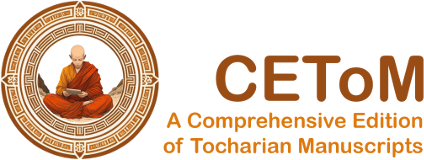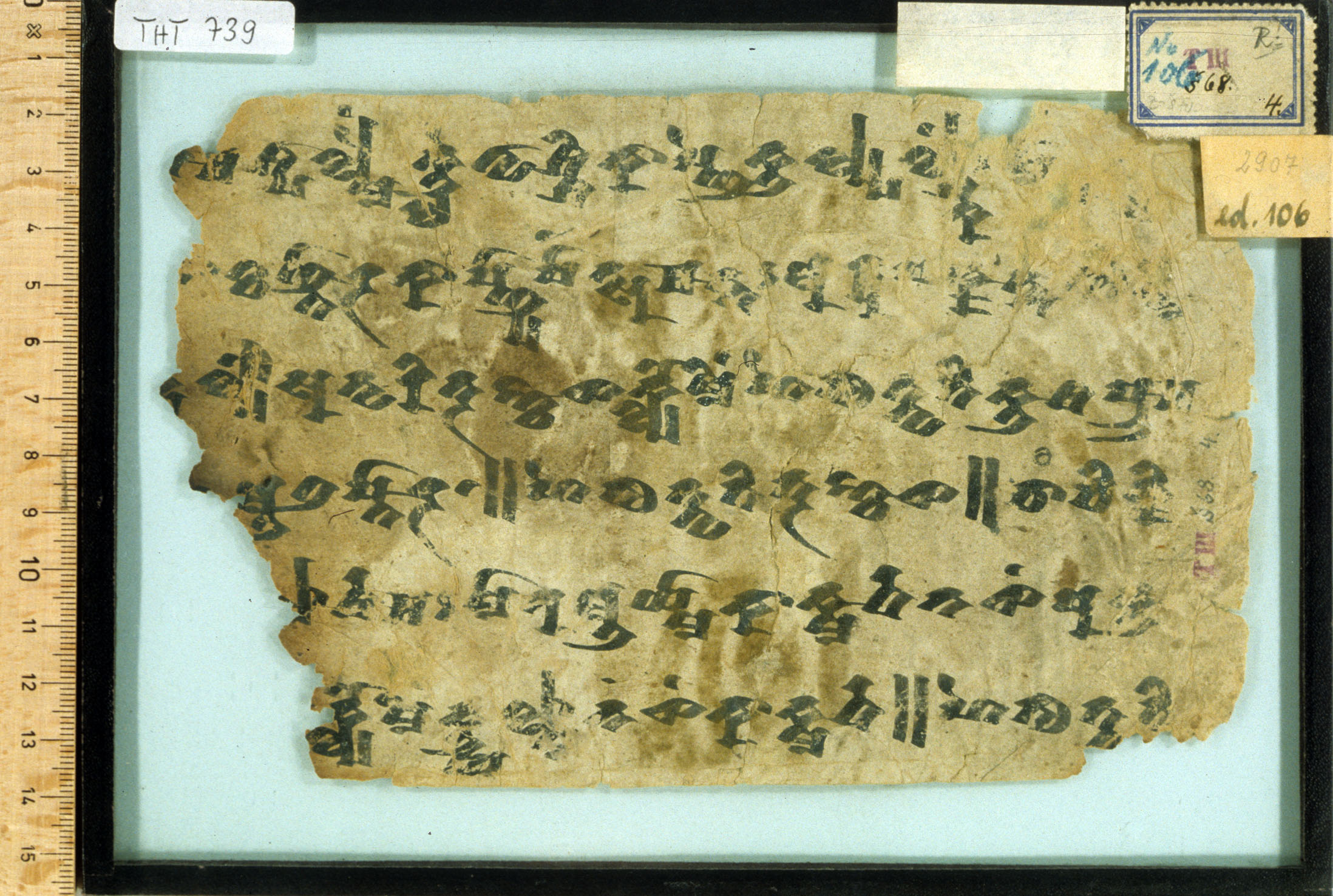A 106
| Known as: | A 106; THT 739 |
|---|---|
| Cite this page as: | Gerd Carling; Adrian Musitz (translation). "A 106". In A Comprehensive Edition of Tocharian Manuscripts (CEToM). Created and maintained by Melanie Malzahn, Martin Braun, Hannes A. Fellner, and Bernhard Koller. https://cetom.univie.ac.at/?m-a106 (accessed 14 Jul. 2025). |
Edition | |
| Editor: | Gerd Carling; Adrian Musitz (translation) |
Provenience | |
| Main find spot: | Shorchuk |
| Specific find spot: | Stadthöhle |
| Expedition code: | T III Š 68.04 |
| Collection: | Berlin Turfan Collection |
Language and Script | |
| Language: | TA |
| Script: | late |
Text contents | |
| Text genre: | Literary |
Object | |
| Manuscript: | A 89-143 |
| Material: | ink on paper |
| Form: | Poṭhī |
| Number of lines: | 6 |
Images
Images from idp.bbaw.de by courtesy of the International Dunhuang Project Berlin, the Berlin-Brandenburgische Akademie der Wissenschaften, and the Staatsbibliothek zu Berlin – Orientabteilung.
Transliteration
| a1 | /// : wi nā sa maṃ ca¯ ¯m pa ltsa¯ ¯k tā rśo na śśä¯ ¯l [y]w· |
|---|---|
| a2 | /// ta¯ ¯r ma¯ ¯r o ṅknaṃ tu¯ ¯ṅk yā mi ta¯ ¯r : o lru ne |
| a3 | /// lkā¯ ¯cä ma¯ ¯nt ñu¯ ¯k lo ma rso : 3 || taṃ ne wka nyo su |
| a4 | /// tra ṅka¯ ¯s̝ taṃ tā¯ ¯s̝ ku pre ne sa¯ ¯m ā lyä kyāṃ kā pñe |
| a5 | /// ¯k ñu knu ṣñi ti ri pā smā¯ ¯r ca¯ ¯s̝ cmo laṃ ca [ma¯] [¯s̝] – |
| a6 | /// ·y[o] he tu twa ti tra ṅka¯ ¯s̝ mā ti ri ci nā [ś]i – – – – |
| b1 | /// ¯m śpā lmeṃ kule wā śśi kā pñe ku lypa lśkaṃ : mā – – |
| b2 | /// ka ñtā¯ ¯r kā pñyā ṣāṃ tsu ma¯ ¯nt : a ryu ṣa kka¯ ¯ts o nm·(·) |
| b3 | /// [kṣ]· lyo su nda ri tra ṅka¯ ¯s̝ klyo miṃ he tu twa ti ku¯ ¯s ṣru¯ ¯m |
| b4 | /// ā la ṣtā¯ ¯r • || he tu twa ti tra ṅka¯ ¯s̝ || cā ci kki |
| b5 | /// lā rsa¯ ¯m : mā nu ā ymā kā kma¯ ¯rt na s̝aṃ ṣu ku |
| b6 | /// klyo miṃ kuya lmā na s̝aṃ kā kma¯ ¯rt || he tu twa ti |
Transcription
| a1 | /// : wināsam-äṃ cam pältsäk tārśonaśśäl yw· |
|---|---|
| a2 | /// tär mar oṅknaṃ tuṅk yāmitär : olrune |
| a3 | /// lkāc mänt ñuk lo märso : 3 ॥ taṃne wkänyo su |
| a4 | /// träṅkäṣ taṃ tāṣ kupre ne säm ālyäkyāṃ kāpñe |
| a5 | /// k ñuk nu ṣñi tiri pāsmār caṣ cmolaṃ camäṣ – |
| a6 | /// ·yo hetutwati träṅkäṣ mā tiri ci nāśi – – – – |
| b1 | /// m śpālmeṃ kulewāśśi kāpñe kulypal śkaṃ : mā – – |
| b2 | /// (nā)käñtār kāpñy āṣāṃtsumänt : aryu ṣakk ats onm(iṃ) |
| b3 | /// kṣ·lyo sundari träṅkäṣ klyomiṃ hetutwati kus ṣrum |
| b4 | /// āläṣtār • ॥ hetutwati träṅkäṣ ॥ cācikki¬ |
| b5 | (naṃ) |
| 1x | 10σ /// lār säm : |
|---|---|
| 1x | mā nu āymā ; kākmart naṣ-äṃ ; ṣu ku b6 2σ |
| * | /// klyomiṃ kuyal mā naṣ-äṃ kākmart ॥ hetutwati |
|---|
Translation
| a1 | ... I honor him... |
|---|---|
| a1+ | The mind with deception... |
| a2+ | Puisse-t-il/elle ne pas aimer un homme... |
| a3 | ... you see... How have I forgotten? |
| a3+ | In this way... |
| a4 | says: |
| a4+ | ... that will be, if he... another beloved... |
| a5 | ... I guard my own manner. In this birth... from him... |
| a6 | ... Hetuvatī says: Your manner (is not to be changed?), mistress... |
| b1 | ... a lover (?) is desireable for excellent women... |
| b2+ | when you happen to blame someone who is worth loving, (you will certainly) regret it for long. |
| b3 | ... Sundarī says forcefully: |
| b3+ | Noble Hetuvatī, what is the reason... |
| b4 | ... you restrain... Hetuvatī says: |
| b4+ | In the cācikkiṃ-tune: |
| b5+ | ... there is no master over his/her self... hither... |
| b6 | ... noble one, why does he/she not have a master? Hetuvatī (says) |
Other
| a2 | Zu einem Mann soll man nicht Liebe fassen! (Schmidt 1974: 341) |
|---|---|
| b2 | ... wenn du einen der Liebe Würdigen tadelst. (Schmidt 1974: 172) |
Commentary
Remarks
| Transcription and translation are based on Carling et al. 2009. | |
| Transcription and references have been transferred from the "Text and Reference Database of the Tocharian A Language" (Gerd Carling Lund University) (funded by the Bank of Sweden Tercentenary Foundation and SCAS). |
References
Online access
Miscellaneous
Edition
Sieg and Siegling 1921: 60; Sieg and Siegling 1921 p. 60
Translations
Carling 2000: a5 (403); Hackstein 1995: b2 (65); Meunier 2013: a2 (172); Schmidt 1974: a2 (341, 482), a2 (341), b2 (172); Thomas 1957: a3 (276); Thomas 1958: a2 (293)
Bibliography
Carling, Gerd. 2000. Die Funktion der lokalen Kasus im Tocharischen. Berlin/New York: de Gruyter.
Carling, Gerd, Georges-Jean Pinault, and Werner Winter. 2009. A dictionary and thesaurus of Tocharian A. Volume 1: Letters a-j. Wiesbaden: Harrassowitz.
Hackstein, Olav. 1995. Untersuchungen zu den sigmatischen Präsensstammbildungen des Tocharischen. HS Erg.-Heft 38. Göttingen: Vandenhoeck & Ruprecht.
“The International Dunhuang Project: The Silk Road Online.” n.d. http://idp.bl.uk.
Meunier, Fanny. 2013. “Typologie des locutions en yām- du tokharien.” Tocharian and Indo-European Studies 14: 123–85.
Schmidt, Klaus T. 1974. “Die Gebrauchsweisen des Mediums im Tocharischen.” PhD, Universität Göttingen.
Sieg, Emil, and Wilhelm Siegling. 1921. Tocharische Sprachreste, I. Band. Die Texte. A. Transcription. Berlin/Leipzig: de Gruyter.
Sieg, Emil, and Wilhelm Siegling. 1921. Tocharische Sprachreste, I. Band. Die Texte. A. Transcription. Personal annotated copy of Wilhelm Siegling. Scanned by Douglas Q. Adams with the technical assistance of Michael Tarabulski and Kevin Dobbins. Berlin/Leipzig: de Gruyter.
Thomas, Werner. 1957. Der Gebrauch der Vergangenheitstempora im Tocharischen. Wiesbaden: Harrassowitz.
Thomas, Werner. 1958. “Zum Gebrauch des prohibitiven mar bzw. mā im Tocharischen.” Central Asiatic Journal 3: 289–308.
Gippert, Jost, Katharina Kupfer, Christiane Schaefer, and Tatsushi Tamai. n.d. “Thesaurus Indogermanischer Text- und Sprachmaterialien (TITUS): Tocharian Manuscripts from the Berlin Turfan Collection.” http://titus.fkidg1.uni-frankfurt.de/texte/tocharic/thtframe.htm.




